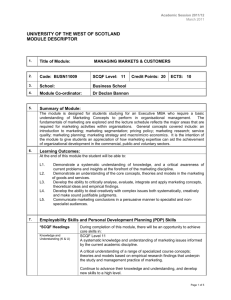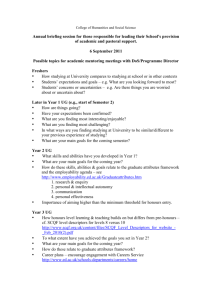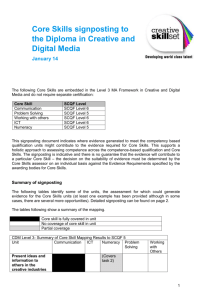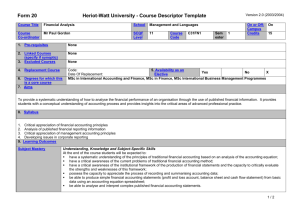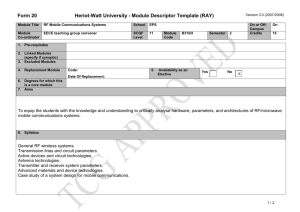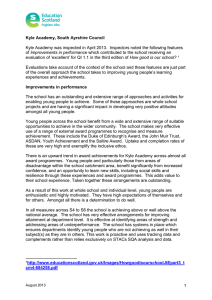An Analysis of Core STEM Skills
advertisement
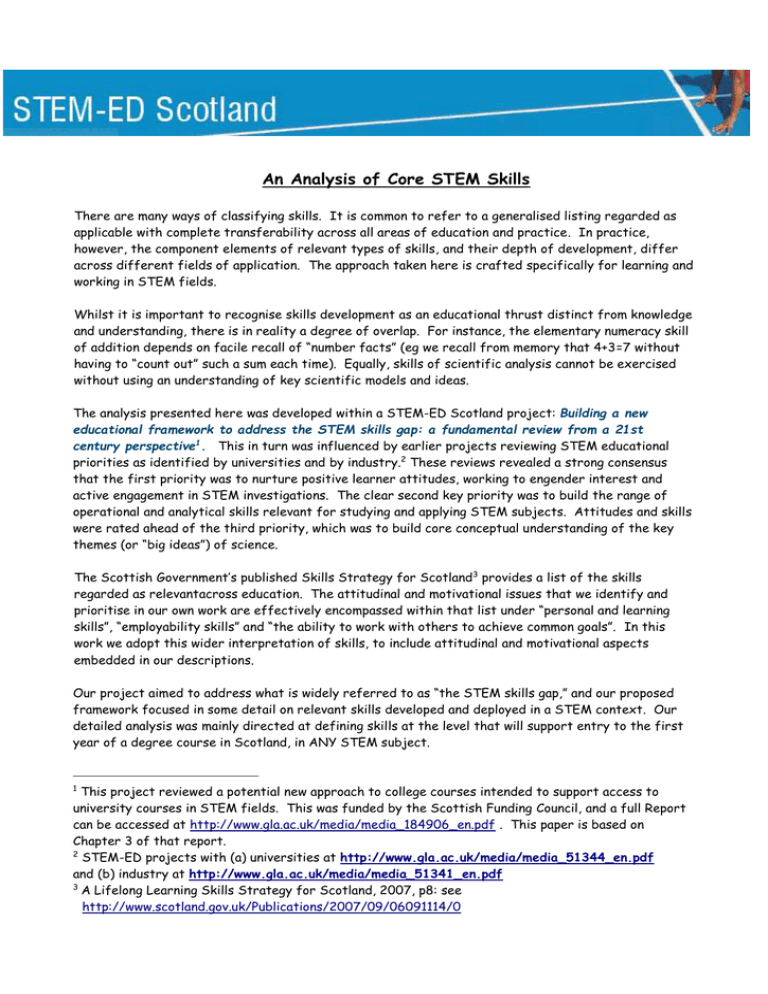
An Analysis of Core STEM Skills There are many ways of classifying skills. It is common to refer to a generalised listing regarded as applicable with complete transferability across all areas of education and practice. In practice, however, the component elements of relevant types of skills, and their depth of development, differ across different fields of application. The approach taken here is crafted specifically for learning and working in STEM fields. Whilst it is important to recognise skills development as an educational thrust distinct from knowledge and understanding, there is in reality a degree of overlap. For instance, the elementary numeracy skill of addition depends on facile recall of “number facts” (eg we recall from memory that 4+3=7 without having to “count out” such a sum each time). Equally, skills of scientific analysis cannot be exercised without using an understanding of key scientific models and ideas. The analysis presented here was developed within a STEM-ED Scotland project: Building a new educational framework to address the STEM skills gap: a fundamental review from a 21st century perspective1. This in turn was influenced by earlier projects reviewing STEM educational priorities as identified by universities and by industry.2 These reviews revealed a strong consensus that the first priority was to nurture positive learner attitudes, working to engender interest and active engagement in STEM investigations. The clear second key priority was to build the range of operational and analytical skills relevant for studying and applying STEM subjects. Attitudes and skills were rated ahead of the third priority, which was to build core conceptual understanding of the key themes (or “big ideas”) of science. The Scottish Government’s published Skills Strategy for Scotland3 provides a list of the skills regarded as relevantacross education. The attitudinal and motivational issues that we identify and prioritise in our own work are effectively encompassed within that list under “personal and learning skills”, “employability skills” and “the ability to work with others to achieve common goals”. In this work we adopt this wider interpretation of skills, to include attitudinal and motivational aspects embedded in our descriptions. Our project aimed to address what is widely referred to as “the STEM skills gap,” and our proposed framework focused in some detail on relevant skills developed and deployed in a STEM context. Our detailed analysis was mainly directed at defining skills at the level that will support entry to the first year of a degree course in Scotland, in ANY STEM subject. 1 This project reviewed a potential new approach to college courses intended to support access to university courses in STEM fields. This was funded by the Scottish Funding Council, and a full Report can be accessed at http://www.gla.ac.uk/media/media_184906_en.pdf . This paper is based on Chapter 3 of that report. 2 STEM-ED projects with (a) universities at http://www.gla.ac.uk/media/media_51344_en.pdf and (b) industry at http://www.gla.ac.uk/media/media_51341_en.pdf 3 A Lifelong Learning Skills Strategy for Scotland, 2007, p8: see http://www.scotland.gov.uk/Publications/2007/09/06091114/0 For STEM education we found it useful to describe skills development under nine headings: S1. Learning, study, self organisation and task planning S2. Inter-personal communication and team working S3. Numeracy: assessing and manipulating data and quantity S4. Critical and logical thinking S5. Basic IT skills S6. Handling uncertainty and variability S7. Experimentation and prototype construction: design and execution S8. Scientific analysis S9. Entrepreneurial awareness Different individuals will have different relative aptitudes. Success in science and engineering is driven by excellence and it is as important to encourage the further enrichment of skills in which an individual has already shown relative strength, as it is to bolster up their areas of relative weakness. It is not therefore sensible to regard skills training as appropriate only up to the point of achieving set minimum threshold levels under each skills heading. In science and industry workplaces team collaboration is required, and different front-line skills are called for in different key operational roles. Each of the skills areas are reviewed below. Given that our approach to STEM education gives high priority to building skills, it is important to indicate the levels of skills competence it is thought reasonable to achieve, in a way that demonstrates appropriate progression. To this end, under each skills strand, we list a series of “indicative characteristic statements” describing capabilities judged appropriate for courses at levels 5, 6 and 7 of the Scottish Credit & Qualifications Framework (SCQF)4. Level 6 is defined as the level justifying entry to entering first year degree courses in Scotland. The national SCQF specifications, intended to apply across all areas of education, give general statements describing the different types of context in which a given skill is demonstrated, typically referring to “simple tasks” at level 5, “more complex situations” at level 6 and “contexts requiring pre-planning” at level 7. Whilst our own statements demonstrate a similar progression to greater complexity we have not adopted the generalised wording. First, it is an overall course that should be designed for a particular SCQF level. Second, our coherent emphasis on the matrix of skills relevant for STEM practice means that we should naturally aim to reach a higher level in the application of, for example, skills in numeracy and analytical analysis. Third and most important, the aims and programme for the exemplar course laid out in Chapter 6 are designed in the light of what we believe to be achievable for students who enter appropriately qualified at the preceding level. Skills are enhanced by being practised and skills development should be embedded within core subject learning: it constitutes a primary purpose of the whole educational process. We believe it is not productive formally to assess each skills category separately, in isolation. Courses should be designed with skills development clearly in mind, and to exercise all aspects during the programme of study. Learners should be encouraged to recognise the key importance of skills and to be conscious of progress and of areas of relative strength and weakness. 4 The SCQF levels are set out at: http://scqf.org.uk/wp-content/uploads/2014/03/SCQF-RevisedLevel-Descriptors-Aug-2012-FINAL-web-version1.pdf 2 S1: Learning, study, self organisation and task planning At root level, skills in this area are particularly dependent on attitudes and motives. Learning is best driven by “thirst”, implying interest and engagement. Deep learning is learning that can be applied and built on, into the long term future, whereas surface learning is what is achieved when the primary motive is to regurgitate particular details or standard tasks at the next examination. To embrace this area course design should i. Be geared, as far as possible, to excite interest and to be seen as relevant for the longer term ii. include signposting (what is about to be studied, and why it is relevant to study it) and retrospective reflection (what has been learned, where this can be useful in future, and its wider significance) iii. involve predominantly active learning, requiring information to be organised and tasks to be planned iv. include formative feedback, involving self-evaluation (or sometimes team-based) and tutor reviews v. involve the learner in self-constructed, carefully organised, and critically reviewed, summary documentation of key knowledge and techniques S1: Indicative characteristic statements about the learner, by level of course by SCQF level 5 by SCQF level 6 i. fully engaged in tasks exercises initiative in pursuing study tasks ii. recognises relevance of existing knowledge to new contexts organise relatively limited and well signposted information; plans approach to welldefined tasks recognises progress made in learning, and areas for improvement produces coherently expressed conclusions from tasks completed iii. iv. v. by SCQF level 7 pro-active in identifying relevant previously acquired knowledge seeks out, assesses the relevance of, and organises effectively, more complex information notes and builds on relevant past understanding, when beginning study of a new topic 3 plans, sometimes with others, relatively complicated and openended tasks recognises the likely value of learning achieved in supporting future study makes increasingly thorough critical reviews of conclusions from study S2: Inter-personal communication and team working These are critical areas for practitioners that tend to be seriously under-played in courses dominated by preparing for traditional formal exams. It is important therefore to incorporate team investigations into a course. These exercises are useful also in developing scientific methodology and broadening understanding. In this context it is important to give explicit attention to the working mechanics of a team i. initially agreeing roles and planning the investigation process and schedule ii. ensuring that the plan includes intermediate dialogue and review meetings iii. nurturing positive interactions across the team, aiming for excellence in accomplishing their task iv. at the end of a study, reflectively reviewing how the team has performed and how effectively each individual has contributed Team working is a very useful context in which to develop inter-personal communication skills, but it does not necessarily capture all important aspects. Also important to pay attention to more generally are: v. communicating information effectively, orally or in writing, to a third party or group vi. interpreting information or advice from a third party, and responding appropriately vii. questioning, discussing and clarifying a topic with another party S2: Indicative characteristic statements about the learner, by level of course i.-iv. by SCQF level 5 by SCQF level 6 by SCQF level 7 participates in teamwork, paying attention to all four aspects – applied to relatively simple exercise(s), with significant briefing supporting the task; progresses in skills levels towards the level 7 goals, with the tasks set designed to “stretch” capabilities steadily Becomes steadily more competent in contributing, in different roles, to team tasks of increasing complexity; gains more experience of presentation, and responds cogently to questioning and in interview discussions with a tutor fronts a section of a team presentation coherently v note that presentation and report writing skills are also referenced under S1(v), S4(ii), S7(vi) and S8(v): here we pick out a dispositional skill underlying most of the other aspects: engages positively and sensitively with third parties in attempting to convey and explain information vi can follow clearly specified instructions successfully asks relevant questions to clarify instructions or advice on tackling a task can work up a task specification provided in summary form, fleshing out intermediate steps vii asks for amplification when uncertain about an explanation given contributes actively to a discussion seeking to put together different aspects of a topic probes the wider significance of information provided, and contributes to dialogue developing deeper of broader understanding 4 S3: Numeracy: assessing and manipulating data and quantity Numeracy has been variously defined. In the Scottish Curriculum for Excellence, for schools, the term has been interpreted almost as a synonym for “arithmetic”. Universities and employers would take a broader view and in a science context in general this would seem more appropriate. In more detail we will regard “numeracy” skills as embracing: i. confidence in dealing with information on a quantitative basis ii. facility and accuracy in arithmetical processes and in basic algebraic manipulations iii. comfort in recognising scale and the relative significance of dominant relative to more minor influences on behaviour; also comfort in applying arguments of scaling through proportion iv. abilities in interpreting information and deriving key conclusions from data presented in tables or in graphs or diagrams; also to present data in suitable ways using these forms v. comfort in using equations to model relationships and to make predictions vi. basic familiarity with elementary geometry, angles and coordinates “Critical and logical thinking” and “handling uncertainty and variability” are also important skills that could be classed within numeracy but which also deserve separate listing below Course design should ensure that all of the above strands are exercised. In the main this will result in the skills being strengthened, and applied with more confidence, through frequent use. Generally, numeracy will be presented within the context of science or engineering topics under review. It is important that there should be provision for enhanced individual support, where necessary. In most instances the main burden on such special support will be to build the learner's self confidence in working with information systematically and carefully. S3: Indicative characteristic statements about the learner, by level of course i. ii. iii. by SCQF level 5 by SCQF level 6 by SCQF level 7 habitually looks to include quantitative information in studies across STEM; quotes values with the number of significant figures appropriate to the context; uses these skills widely in the more complex curriculum context takes care consistently to quote the units when giving values for quantities carries through the whole range of arithmetic operations with reasonable confidence; applies the rules of algebra when manipulating expressions and equations uses scientific notation comfortably; quotes values with an estimated uncertainty range as appropriate through practice becomes both efficient and securely accurate in both arithmetic and algebraic manipulations applies scaling involving direct proportion accurately handles calculations involving quantities expressed in scientific notation, including handling of unit prefixes; handles cases involving multiple and complex proportion (where relationships involve inverse proportion or other powers) 5 uses mature skills routinely, in the more complex contexts met in the disciplines being studied uses mature skills routinely, in the more complex contexts met in the disciplines being studied iv. & v identifies trends and anomalies in tabulated data or graphs; derives relationships fitting trends in data; constructs suitable graphs or tables to present data, and inter-relationships clearly; extends skills in these areas by applying them in more diverse and complex contexts, eg: - logarithmic plots - handling multiple equations in problem solving can estimate the gradient of a tangent to a curve, and the area under a segment of a curve; vi plots graph of data suggestive of a linear relationship, and hand draws best line fit; makes estimates involving interpolation and extrapolation, with some judgement of an error range solves pair of linear equations involving two unknowns finds the equation for a handdrawn straight line graph uses “x,y” cartesian coordinates comfortably in applications (eg mapping); manipulates equations to change the subject and to cross substitute into other equations reinforce these skills and develop them forward as described through the level 6 mathematics agenda, applied routinely to scientific and engineering contexts can apply relationships between angles in triangles and involving intersecting or parallel lines; can relate the trigonometric functions sin, cos and tan to ratios of the sides of right angled triangles, and to projections on to Cartesian axes; uses Pythagoras theorem via the 2d distance formula 6 carry the skills to more comples contexts, eg: - distance formula in 3D - use polar coordinates S4: Critical and logical thinking Critical and logical thinking can be regarded as perhaps the single most fundamental intellectual tool that characterises scientific and mathematical thinking. It underlies scientific analysis and is a key ingredient of problem solving. It can be described under a series of sub-headings: i. extracting the sense of an argument or explanation expressed in a text source ii. describing observations, explaining a concept or making an argument in a clear and well organised way, orally or in writing iii. applying logic to deduce conclusions from evidence, or in formal mathematical proofs iv. identifying weaknesses and contradictions in arguments and explanations and identifying where there might be significant missing information v. carrying through standard mathematical manipulations for a set purpose as in rearranging an equation to change its object Critical thinking skills are very important and should feature centrally in assessment: this requires reasonably extensive and relatively “open” examination questions. S4: Indicative characteristic statements about the learner, by level of course by SCQF level 5 i-v i ii iii by SCQF level 6 by SCQF level 7 The major difference between the different levels will be in the sophistication of the studies and exercises undertaken. It should be a prime factor in setting the depth of study of topics and the complexity of tasks set, and also in designing assessment, that the level of demand on each aspect of these skills is appropriately exercised across a course. re-expresses the argument handles rather longer texts and writes of presents a clear of the text studied in their applies some judgement to précis summarising the key own words summarise the key points points made writes clear reports of makes good contributions in a can produce well-structured simple experiments, team context, towards building more extensive reports, explaining the purpose, a well argued joint report or including references to source setting out observations, and presentation materials as appropriate and a deriving the conclusions critical assessment of conclusions can identify successive steps can rehearse some examples of in contributing to scientific for solving an appropriate formal proofs in mathematics, debate or discussion with level of multi-step problem including proof by induction (not others, arguments made are intended for formal exam test); clearly rooted in a logical analysis of the issue at stake shows a strategic approach to problem solving, founded on logical analysis 7 iv recognises situations where more than one scientific explanation might apply can suggest studies that could add new information that might resolve a conflict between alternative explanations; critically analyses conflicting accounts of a controversial area where different scientific explanations have been propounded identifies cases where unsound scientific conclusions may have been reached because of unjustified assumptions or factors overlooked v recognises that scientific models may have a limited range of applicability (eg ideal vs real gases, Newton’s laws cf motions within atoms and across space) applies the numeracy skills levels described under S3(v) strategically in problem solving 8 S5: Basic IT skills Under this heading we group basic capabilities in using a family of standard IT packages as tools in other studies. Nowadays most learners acquire a large proportion of these skills outside of formal education, and if teamwork is undertaken further reinforcement is likely through peer interaction. It is important, however, to be able to provide bespoke help where this is needed. This applies to: i. basic computer operation, including file handling, directory organisation and downloading ii. basic word processing, internet searching, presentation software and emailing More structured attention is likely to be required in: iii. use of a spreadsheet package, applying formulae and functions and generating plots iv. use of specialised graphics packages where required (eg CAD, molecular modelling) S5: Indicative characteristic statements about the learner, by level of course i. & ii iii. iv. by SCQF level 5 by SCQF level 6 by SCQF level 7 has basic proficiency in all areas mentioned can use a spreadsheet in simple applications to tabulate, rearrange and sum data skills used as required skills used as required can effect data manipulations involving a range of formulae, and can produce standard charts and graphs can use relevant packages after receiving briefing applies spreadsheet skills in more complex ways, eg deriving the equation for a linear regression fit to data 9 S6: Handling uncertainty and variability Historically this area has been much neglected in STEM education. Study has tended to focus almost exclusively on well-established areas, where the behaviour of a given system fits a simple model and is consistently reproduced accurately, so that for every problem or experiment studied there is a predictable and “right” answer. It is generally recognised that experimental measurements are subject to errors depending on the equipment and techniques employed, but the traditional emphasis has been on what the “true” result “should” be. At the frontiers of science, and particularly in many of the complex issues that feature in public debate, modelling of the science is much more uncertain. Also, in very many new potential applications of science there are risks to be balanced against benefits. Statistical analysis is important in understanding the reliability of artefacts, the variability of characteristics in a population, and in analysing random experimental error. Probability and statistics have traditionally been introduced relatively late in mathematics education, in a rather general and abstract context where it is traditionally found rather difficult. There is an important job to be done here to introduce ideas of uncertainty and variability in the context of science and engineering applications, and to link this to treatment within mathematics. Aspects include: i. basic examples involving random events and their probabilities ii. examining risks from data such as rates of incidence of specific diseases or accidents iii. ranking risks from severe through significant to negligible iv. experience of judgements required balancing risks against benefits v. analysing reliability and breakdown data for manufactured equipment, and design issues vi. recognising the inherent variability within samples and in populations vii. recognising that experimental measurements are subject to random and systematic error viii. understanding the basic idea of a statistical distribution, and ideas of mean, median, mode and standard deviation ix. recognising that scientific modelling of complex situations can carry inherent uncertainties (eg weather forecasting) S6: Indicative characteristic statements about the learner, by level of course i - iv by SCQF level 5 by SCQF level 6 by SCQF level 7 accurately uses the concept of probability in simple contexts and recognises that risk assessment involves consideration of probability and severity of its occurrence can carry through quantified risk assessment exercises for practical activities, and discuss risk versus benefit issues for a technology development can describe and defend a quantitative risk assessment exercise for an engineering project contributes to a case study involving the reliability of a product; includes error estimates where appropriate when reporting experimental results, using mean and standard deviation; routinely considers reliability in a design exercise note crossover to ongoing Mathematics development note crossover to ongoing Mathematics development v vi - viii recognises the uncertainties inherent in studies of samples and in experimental measurements, and makes broad estimates of the impact of this on conclusions reached 10 can carry through some basic tests of statistical significance (eg t-test); ix can contribute in a balanced way to a general discussion of the uncertainties in a given scientific prediction participates in an objective way to a reasonably detailed analysis of alternative scientific predictions (eg in climate modelling) 11 routinely comments, in a technically sound way, on uncertainties when reporting conclusions S7: Experimentation and prototype construction: design and execution A good and varied experience of practical work, involving experimentation in the sciences and construction of physical models and graphic diagrams in engineering, needs to be a significant feature in STEM education at any level. Over a course, exercises should be designed so as to give experience of all of the following: i. reinforce study by observing real life scenarios in operation ii. engage learners in some pre-planning and design for exercises iii. give some appreciation of, and practice in applying the technical and craft skills involved in careful execution of the task, aiming for maximum accuracy and precision iv. require careful observation and recording of outcomes v. involve a reflective review of the conclusions resulting, and their accuracy or reliability vi. involve some instances requiring report writing, critically reviewed There is a place for practical demonstrations in science, and these can be very valuable for the first aspect above. However, direct learner experience must play a major part in addressing this skill area as a whole. S7: Indicative characteristic statements about the learner, by level of course by SCQF level 5 i - vi by SCQF level 6 by SCQF level 7 exercises and progressively builds all of these skills areas in the course of study, with exercises becoming more complex and extensive in higher level courses of study 12 S8: Scientific analysis This heading represents the distinctive methodology that characterises scientific thinking, building on the numeracy, critical thinking and practical skills described above. It is convenient to distinguish five complementary sub-headings, which are applied sequentially in following through a scientific investigation or study. In engineering these basic skills underlie important systematic methodologies in project planning, process optimisation, quality assurance, etc. (i) Clarifying the scope and objective of a study, and setting its context It is important to define the focus and scope of a study or investigation from the start, to have clear objectives and to review the context of the study in terms of what else is known. Information gathered during the exercise, or issues emerging during analysis, may necessitate a review: it is important to retain clarity of purpose at all stages. (ii) Investigation: accruing and judging information Skills involved in practical investigations have been reviewed above. In accruing information from published sources, skills needs to be developed in searching for and locating relevant sources, and in judging both the reliability and the relevance of the data obtained. There should always be an attempt to assess, and if possible to quantify, the accuracy of data, and the extent to which this affects the validity and accuracy of the eventual conclusions from the study. (iii) Critical analysis and modelling: building on fundamentals Outstanding scientists and engineers are noted for the clear and focused way they approach any new problem from first principles. Modelling constitutes the key organiser in scientific understanding. In any scientific analysis it is important to frame one's thinking in terms of the key concepts and ideas that are the subject of Sec 4 below. This gives a context for addressing the issue or problem in hand, using the appropriate skills and methodologies. (iv) Assessing conclusions appropriately, objectively, and critically This is an area that tends to be neglected in traditional approaches to the curriculum, in that for most situations addressed a definite and “correct” answer is expected. Where more open-ended and student-centred investigations are pursued, the conclusions are often not definitive. Deficiencies and limitations of the study should be considered, and further work might be suggested that would test tentatively derived conclusions. Where alternative explanations might be possible, these should be mentioned. Where science reveals the feasibility and potential impact of applying a process or technology, a clear distinction should be recognised between the objective scientific analysis and the non-scientific subjective (and sometimes ethical) value judgements involved in any policy decision on implementation (as discussed more fully under ideas about science in Chapter 5). Where quantitative conclusions are drawn, there should be some discussion of accuracy. (v) Report writing, presentation and discussion of conclusions Reporting skills require to be developed through practice and feedback, including participating in reviewing presentations by peers. Important skills areas in reporting include: logical and clear exposition setting the work in its broader context a critical analysis of conclusions identification of where, given time, further work would be appropriate pitching the level and scale of the report to fit its planned purpose 13 S8: Indicative characteristic statement about the learner, by level of course by SCQF level 5 i-v by SCQF level 6 by SCQF level 7 exercises all of these skills areas in the course of study, with the context becoming more complex, as dictated by the progressing demand of the curriculum topics and exercises in higher level courses of study S9: Entrepreneurial awareness In addition to deepening our understanding of the world, science, engineering and mathematics have enabled humanity to transform lifestyles, in terms of wealth, health, work, and social and leisure activities. In the modern world the relative prosperity of nations depends considerably on how effectively they can contribute to the innovation that drives economic success. Typically this requires talent in the timely and efficient application of scientific and engineering ideas to creation of a new “product” that will attract interest and demand. Similar talent is required on an on-going basis, to evolve the design and production of an existing “products” to keep up with new knowledge and evolving demands. The term “product” here is intended to include artefacts, procedures and services. The skills involved here are, first, in spotting relevant opportunities for innovation and, secondly, in the timely and effective realisation of such an opportunity. Aiming to nurture these skills through education is a relatively recent development, in response to a recognition that in the past, notable scientific breakthroughs achieved in the UK have frequently been exploited, with spin-off economic benefits, elsewhere. At root these skills are by no means peculiar to the STEM disciplines; they are vital to the launch and operation of any successful business, and indeed to the management and delivery of efficient and effective public services. On the other hand STEM applications provide the key drivers for innovation, world-wide. In the current context the skills (and attitudes) to nurture are: i. “brain-storming” analysis of potential new applications built on scientific knowledge ii. recognition of opportunities and constraints linked to Intellectual Property rights iii. general understanding of the significance of business issues, including finance and marketing iv. recognition of the importance of applying skills in a. analysis of uncertainty and risk (skills area F above) b. project management (using methodologies discussed under Engineering in Section 5b) c. team working (skills area B above) v. analysis of critical features in case studies of successful and unsuccessful STEM-rooted entrepreneurial ventures S9: Indicative characteristic statements about the learner, by level of course i. - v by SCQF level 5 by SCQF level 6 by SCQF level 7 is aware that applications of STEM ideas and principles has transformed human life is aware of the importance of this area to economic and social advance and recognises the significance of the factors identified under headings i through v can actively engage in discussions of case studies involving entrepreneurial innovation a 14
